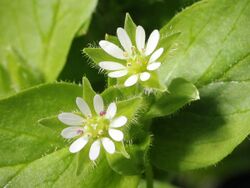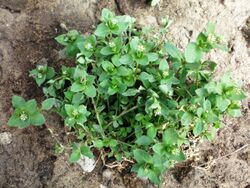Stellaria media
Topic: Biology
 From HandWiki - Reading time: 6 min
From HandWiki - Reading time: 6 min
| Common chickweed | |
|---|---|

| |
| Scientific classification | |
| Kingdom: | Plantae |
| Clade: | Tracheophytes |
| Clade: | Angiosperms |
| Clade: | Eudicots |
| Order: | Caryophyllales |
| Family: | Caryophyllaceae |
| Genus: | Stellaria |
| Species: | S. media
|
| Binomial name | |
| Stellaria media (L.) Vill.
| |
| Synonyms | |
| |
Stellaria media, chickweed, is an annual flowering plant in the family Caryophyllaceae. It is native to Eurasia and naturalized throughout the world, where it is a weed of waste ground, farmland and gardens. It is sometimes grown as a salad crop or for poultry consumption.
Description
Chickweed is a hardy annual which flowers throughout the year in northern Europe, in mild weather.[1] The stems are terete and glabrous with a lax and sprawling growth habit, up to 400 mm (16 inches) long and 1 mm (0.039 inches) in diameter, with a line (very occasionally 2 lines) of hairs running straight down its length, alternating sides at the nodes. The petioles are 5 to 8 mm long with hairy margins. The leaves are green, hairless, oval and opposite, 6 to 25 mm long by 3 to 10 mm wide with a hydathode at the tip.[2][3]
The flowers are small, about 1 cm in diameter, with 5 bifid white petals, 1–3 mm long, nestled inside the larger (3–5 mm long) sepals. These sepals have long, wavy (villous) hairs on their outer (distal) sides and are oval in shape, and usually 5 in number. There are often only 3 stamens but sometimes more (up to 8) and 3 styles. Many publications state that chickweed sometimes has no petals at all, but this may be due to confusion with lesser chickweed, which used to be considered a subspecies but is now considered to be a species in its own right.[4][3][5][6]
The flowers quickly form capsules. Plants may have flowers and capsules at the same time.
Taxonomy
The name Stellaria media was published by Domínique Villars in Histoire des plantes du Dauphiné in 1789. It has accumulated a huge number of synonyms since then, as well as many putative varieties and subspecies, very few of which are accepted today.[7]
The name Stellaria is derived from the word 'stella' meaning 'star',[8] which is a reference to the shape of its flowers; media is Latin for 'between', 'intermediate', or 'mid-sized'.[9]
It is sometimes called common chickweed to distinguish it from other plants called chickweed. Other common names include chickenwort, craches, maruns, and winterweed.
Identification
Chickweeds are recognisable by the line of hairs down the stem. The species most likely to be confused with chickweeds are mouse-ears (Cerastium), however, mouse-ears are hairy all over (leaves and stems).
Common chickweed can be differentiated from lesser chickweed by the presence of white petals on the former and from greater chickweed by 3 stamens present compared to 10 found in greater chickweed. Water chickweed has petals longer than the sepals. [2]
Distribution
Stellaria media is widespread in Asia, Europe, North America, and other parts of the world. There are several closely related plants referred to as chickweed, but which lack the culinary properties of plants in the genus Stellaria.
Habitat and ecology
Stellaria media is common in lawns, meadows, waste places, and open areas.[10][11] Its Ellenberg values in Britain are L = 7, F = 5, R = 6, N = 7, and S = 0.[12]
The larvae of the following species of Lepidoptera feed on chickweed: chickweed geometer (Haematopis grataria), yellow shell (Camptogramma bilineata), pale-banded dart (Agnorisma badinodis), dusky cutworm (Agrotis venerabilis) and dainty sulphur (Nathalis iole). It is susceptible to downy mildew caused by the oomycete species Peronospora alsinearum.[13]
Uses
Stellaria media is edible and nutritious, and is used as a leaf vegetable, often raw in salads.[14] It is one of the ingredients of the symbolic dish consumed in the Japanese spring-time festival, Nanakusa-no-sekku. Some varieties or similar species may be too fibrous to eat.[15]
It is also eaten by chickens, wild birds, and mountain sheep.[16][17]
Chickweed contains plant chemicals known as saponins, which can be toxic to some species (notably fish). It is unlikely that most land animals will be affected, as the quantities involved are not large. However, it is not advised for pregnant and breastfeeding mothers.[18]
It is said to have medicinal properties and is used in folk medicine. It has been used as a remedy to treat itchy skin conditions and pulmonary diseases.[19] 17th-century herbalist John Gerard recommended it as a remedy for mange. Modern herbalists prescribe it for iron-deficiency anemia (for its high iron content), as well as for skin diseases, bronchitis, rheumatic pains, arthritis, and period pain.[20] Not all of these uses are supported by scientific evidence.[21] The plant was used by the Ainu for treating bruises and aching bones. Stems were steeped in hot water before being applied externally to affected areas.[22]
Chemistry
The anthraquinones emodin, parietin (physcion) and questin, the flavonoid kaempferol-3,7-O-α-L-dirhamnoside, the phytosterols β-sitosterol and daucosterol, and the fatty alcohol 1-hexacosanol can be found in S. media.[23] Other flavonoid constituents are apigenin 6-C-beta-D-galactopyranosyl-8-C-alpha-L-arabinopyranoside, apigenin 6-C-alpha-L-arabinopyranosyl-8-C-beta-D-galactopyranoside, apigenin 6-C-beta-D-galactopyranosyl-8-C-beta-L-arabinopyranoside, apigenin 6-C-beta-D-glucopyranosyl-8-C-beta-D-galactopyranoside, apigenin 6, 8-di-C-alpha-L-arabinopyranoside.[24] The plant also contains triterpenoid saponins[25][26] of the hydroxylated oleanolic acid type.[27] Proanthocyanidins are present in the testa of seeds.[28]
See also
- Nanakusa-no-sekku
References
- ↑ "Stellaria media". RHS. https://www.rhs.org.uk/Plants/119111/Stellaria-media/Details.
- ↑ 2.0 2.1 Stace, C.A. (2019). New Flora of the British Isles. Suffolk. ISBN 978-1-5272-2630-2.
- ↑ 3.0 3.1 Poland, John; Clement, Eric (2009). The Vegetative Key to the British Flora. Southampton: John Poland. ISBN 978-0-9560144-0-5.
- ↑ Parnell, J. and Curtis, T. 2012. Webb's An Irish Flora. Cork University Press. ISBN:978-185918-4783
- ↑ Rose, Francis (2006). The Wild Flower Key. London: Frederick Warne. ISBN 978-0-7232-5175-0.
- ↑ Stellaria media var. apetala (Ucria ex Roem.) Gaudin. "Global Biodiversity Information Forum". https://www.gbif.org/species/8067252.
- ↑ Global Biodiversity Information Facility. "Stellaria media (L.) Vill.". https://www.gbif.org/species/5384604.
- ↑ Stearn, William T. (1980). Botanical Latin: History, Grammar, Syntax, Terminology and Vocabulary. Newton Abbot: David & Charles. ISBN 0-7153-5645-3.
- ↑ Gledhill, David (2008). "The Names of Plants". Cambridge University Press. ISBN:9780521866453 (hardback), ISBN:9780521685535 (paperback). pp 253, 361
- ↑ Hackney, P. (ed) 1992. Stewart and Corry's Flora of the North-east of Ireland. Institute of Irish Studies, The Queen's University of Belfast. ISBN:0-85389-446-9(HB)
- ↑ Webb, D.A. Parnell, J. and Doogue, D. 1996. An Irish Flora. Dundalgan Press (W.Tempest) Ltd. ISBN:0-85221-131-7
- ↑ Hill, M.O.; Mountford, J.O.; Roy, D.B.; Bunce, R.G.H. (1999). Ellenberg's indicator values for British plants. ECOFACT Volume 2. Technical Annex. Institute of Terrestrial Ecology. ISBN 1870393481. http://nora.nerc.ac.uk/6411/1/ECOFACT2a.pdf. Retrieved 29 May 2017.
- ↑ Constantinescu, O. (1991). "An annotated list of Peronospora names". Thunbergia 15.
- ↑ Stellaria media at Plants for a Future
- ↑ Benoliel, Doug (2011). Northwest Foraging: The Classic Guide to Edible Plants of the Pacific Northwest (Rev. and updated ed.). Seattle, WA: Skipstone. pp. 63. ISBN 978-1-59485-366-1. OCLC 668195076. https://www.worldcat.org/oclc/668195076.
- ↑ Niering, William A.; Olmstead, Nancy C. (1985). The Audubon Society Field Guide to North American Wildflowers, Eastern Region. Knopf. p. 462. ISBN 0-394-50432-1.
- ↑ Angier, Bradford (1974). Field Guide to Edible Wild Plants. Harrisburg, PA: Stackpole Books. pp. 62. ISBN 0-8117-0616-8. OCLC 799792. https://archive.org/details/fieldguidetoedib00angi/page/62/mode/2up.
- ↑ "Stellaria media". Plants for a future. https://pfaf.org/User/plant.aspx?LatinName=Stellaria+media.
- ↑ Hensel, Wolfgang (2008). Medicinal plants of Britain and Europe. London: A&C Black. ISBN 9781408101544.
- ↑ Wiest, Renee. "Chickweed". Good Health Herbs. http://hartonweb.com/nsp-herbs/goodhealthherbs.com/?sn=220-2.
- ↑ Howard, Michael (1987). Traditional folk remedies : a comprehensive herbal. London: Century. p. 119. ISBN 0-7126-1731-0.
- ↑ Batchelor, J. and Miyabe, K. (n.d.). Ainu economic plants. 1st ed. 1893.
- ↑ Studies on the Chemical Constituents From Stellaria media (II). Huang Yuan, Dong Qi, Qiao Shan-Yi, Pharmaceutical Journal of Chinese People's Liberation Army, 2007-03 (abstract) (Article in Chinese)
- ↑ Dong, Q; Huang, Y; Qiao, SY (2007). "Studies on chemical constituents from stellaria media. I" (in zh). Zhongguo Zhong Yao Za Zhi = Zhongguo Zhongyao Zazhi = China Journal of Chinese Materia Medica 32 (11): 1048–51. PMID 17672340.
- ↑ Hu, Y.M.; Wang, H.; Ye, W.C.; Qian, L. (2009). "New triterpenoid fromStellaria media(L.) Cyr". Natural Product Research 23 (14): 1274–8. doi:10.1080/14786410701642532. PMID 19735039.
- ↑ Weng, A; Thakur, M; Beceren-Braun, F; Gilabert-Oriol, R; Boettger, S; Melzig, MF; Fuchs, H (2012). "Synergistic interaction of triterpenoid saponins and plant protein toxins". Planta Medica 78 (11). doi:10.1055/s-0032-1320271.
- ↑ Böttger, Stefan; Melzig, Matthias F. (2011). "Triterpenoid saponins of the Caryophyllaceae and Illecebraceae family". Phytochemistry Letters 4 (2): 59. doi:10.1016/j.phytol.2010.08.003. Bibcode: 2011PChL....4...59B.
- ↑ Bittrich, V.; Amaral, Maria Do Carmo E. (1991). "Proanthocyanidins in the testa of centrospermous seeds". Biochemical Systematics and Ecology 19 (4): 319. doi:10.1016/0305-1978(91)90020-Z.
Further reading
- Everitt, J.H.; Lonard, R.L.; Little, C.R. (2007). Weeds in South Texas and Northern Mexico. Lubbock: Texas Tech University Press. ISBN:0-89672-614-2
- Tilford, Gregory L. (1997). Edible and Medicinal Plants of the West. Mountain Press Publishing Company. ISBN 0-87842-359-1.
External links
Wikidata ☰ Q158711 entry
 |
 KSF
KSF




